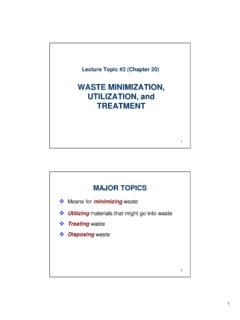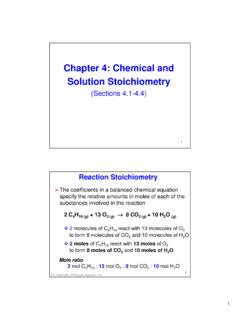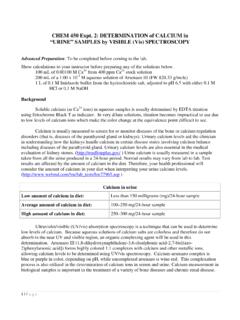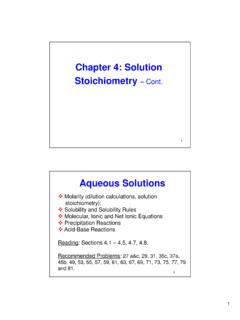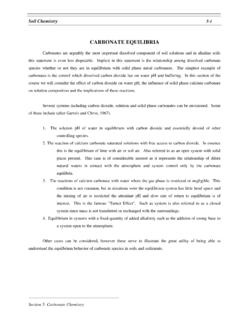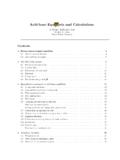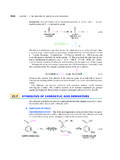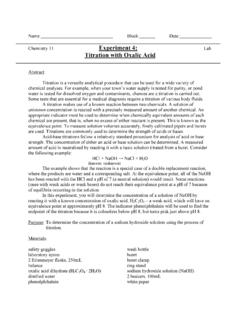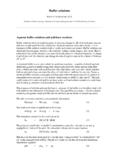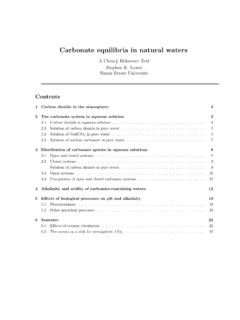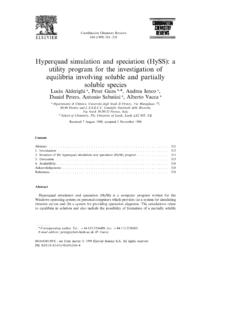Transcription of Lec7 Ch11 AcidBase Titn - Bridgewater State University
1 1 Chapter 10 acid - base TITRATIONS1 Strong acid -Strong base TitrationsAbbreviationsExample:A mL solution of M NaOH is titrated with M HCl. Calculate the pH of solution at the following volumes of HCl added: 0, , Ve, and ++ OH-H2 OVa= volume of strong acid , volume of strong base , vol. titrant acid or base needed to reach the equivalence pointNet ionic equation:What is K for this reaction at 25 0C?K = 1/Kw Very large K; reaction goes to Titrations(Cont.)WORK:First you must determine VeSince the reaction stoichiometry is 1:1, mol H+= mol OH-At the equiv. ,Max Va= Mbx VbSince HCl is the titrant we substitute Vefor Va:Max Ve= Mbx VbAt the equiv. VbMaSubstituting the given quantities we get:Ve= {( mL)( M)} MVe= Titrations(Cont.)Calculate the solution pH at different Va sRegion 1: Before the equivalence point(WhenVa< Ve)(a) pH when Va= 0 What species is in solution?
2 There is unreacted NaOH in solution, so the pH is still basic Amount of excess NaOH determines pH Only M NaOH is solution,pOH = - log ( M) = = Va= 043 Region 1: Before the equiv. pt.(Cont.)(b) pH when Va= mL Since Ve= mL, we know that Va= mL is only 20 % of Ve Thus, 80 % of NaOH remains unreacted But wait, the total volume of has been changed by addition of titrant! Titrations(Cont.)5 WORK Cont.(b) pH when Va= mL Use changes in # moles OH-during titration with H+ to calc. pH [OH-] =Initial mol OH-- mol OH-reactedVtot[OH-] =[( M)( mL)] - ( M)( mL)pH = Va= mL= mol H+added= mol H+ mL[OH-] = x Titrations(Cont.) Titrations(Cont.)Calculate the solution pH at different Va sRegion 2: At the equivalence point(WhenVa= Ve)What species is in solution? Equimolar amounts of HCl and NaOH have reacted to form NaCland H2O NaCl is made of spectator ions, => gives neutral pH in solutionThus, pH = the equivalence Titrations(Cont.)
3 Region 3: Beyond the equivalence point(WhenVa> Ve)What species is in solution? Excess titrant, H+, determines solution pHpH when Va= mL mL of H+is in excess of Ve Do not ignore dilutionVa- VeVtot[H+]x s= Maxvol. in x s of Ve= ( M) mL ( + ) mL [H+]x s= x 10-4M; pH = Va> Titrations(Cont.)Alternative work: Construct an I-C-F table (F = final). Remember that titration reactions go to completion so there is no equilibrium (E).Example:A mL solution of M NaOH is titrated with M HCl. Calculate the pH of solution at the following volumes of HCl added: (a) , (b) Ve, and (c) ++ OH-H2 OWORK: (a) when Va= mLNote: Vtotalsol n = mL mol added H+= Ma xVa= x 10-4 initial mol OH-= Mb xVb= x 10-4 I (mol): x x 10-4liquidC (mol): - x 10-4- x 10-4liquidF (mol): x 10-4liquid[OH-]434 OHxmolxMVL ===pOH = ; pH = Titrations(Cont.)
4 Alternative work(Cont)H++ OH-H2 OWORK: (c) when Va= mLNote: Vtotalsol n = mL I (mol): x x 10-4liquidC (mol): - x 10-4- x 10-4liquidF (mol): x 10-40liquid[H+]x HxmolxMVL+ ===pH = : Consider the titration of mL of M HBr with M KOH. Calculate the pH at the following volumes of KOH added: 0, , and Titrations(Cont.)11 Titration Curves:Strong acid -strong base titrationStrong acid titrated with a strong baseVacidpHStrong base titrated with a strong acid pH is acidic before the equiv. pt. (H+in sol n) pH = 7 at the equiv. pt. pH is basic (due to x s OH-beyond the equiv. pt. pH is basic before the equiv. pt. (OH-in sol n) pH = 7 at the equiv. pt. pH is acidic (x s H+beyond equiv. acid -Strong base TitrationsHA + OH-A-+ H2 OTitration reaction:HATitrant (always)Calculate the solution pH at different Va sRegion 1: Before the equivalence point(WhenVb< Ve)What species is in solution?))
5 Only HA in solution, so the pH is acidic Calculate pH from amount of HA that dissociatedExample:Consider the titration of mL of M formic acid with M NaOH. Calculate the pH of solution at the following volumes of NaOH added: 0, , Ve, and acid Titrant Conj. base K = 1/Kb (A-)= very large; Reaction goes to Titrations(Cont.)Region 1: Before the equivalence point(Cont.)(a) pH when Vb= 0 mL(Only HA in solution)Solution equilibria:HA H++ A- Use Kaand FHAto calculate pH(Ka= x 10-4for formic acid )Ka= x2 FHA- xx2( x) x 10-4=Solving for x quadratically we get:x = [H+] = x 10-3 MpH = Vb= Titrations(Cont.)Region 1: Before the equivalence point(Cont.)(b) pH when Vb= mL Some HA have reacted to form A- Mixture of unreacted HA and A-= a buffer!
6 15 Work: Use moles and I-C-F table Keep track of total vol. solution, VtotalWe have to know Vefirst:Ve=Max VaMb= [( M)( mL)]/( M)Ve= mL Thus, Vb< Ve, so the equiv. pt. has not been x x 10-40 ---Titration reaction:HA + OH-A-+ H2O- x 10-4- x 10-4+ x x 10-40 x 10-4---initial mol HA =MHAx VHAmol OH-reacted = Mbx VbInitial mol (I):Change (C):Final mol (F):pH = + x x 10-4pH = ( mol/L)( L)= x 10-3mol= ( mol/L)( L)= x 10-3mol9 Titration reaction:HA + OH-A-+ H2O Alternative work: Use of volume fractionsWe have to know Vefirst:Ve=Max VaMb= [( M)( mL)]/( M)Ve= mL25/25 10/25 0 ---Relative initial amounts:15/25 0 10/25 ---Relative final amounts:- 10/25 - 10/25 + 10/25 ---Change:17pH = pKa+ log[A-][HA]pH = + log10/2515/25when Vb< VepH = 2.
7 At the equivalence pointpH when Vb= VeWhat species is in solution? All the HA has been converted to A-, a weak base Hydrolysis of A-will determine solution pHSolution equilibria:A-+ H2O HA + OH-Kb First, calculate FA-, then use Kband FA-to calculate the pH of solutionFA-=Vtotmol A-=initial mol HAVtot=( M)( mL)( + ) mLFA-= Titrations(Cont.)1810 Region 2: At the equivalence pointpH when Vb= Ve(Cont.)FA-= MKb= y2FA-- yKb=Kw/( x 10-4) = x 10-11 Substituting and solving for y gives:y = [OH-] = x 10-6 MpOH = pH = the equiv. pt. pHat the equiv. pt. > 7because A-is a weak Titrations(Cont.)19 Region 3: Beyond the equivalence point(WhenVb> Ve)What species is in solution?[OH-]x s= x 10-4M;pOH = pH = the equiv. pt. Excess titrant, NaOH; mL is in excess of Ve [OH-]x sdetermines solution pH[OH-]x s= MbxVb- VeVtot= ( M) x ( mL) Titrations(Cont.)
8 2011 Summary(1) Before titration Only HA in solution; Use Kaequil. to calculate pH Mixture of unreacted HA and A-= buffer(2) Before the equiv. pt. (Vb< Ve)pH = pKa+ log[A-][HA](3) At the equiv. pt. (Vb= Ve) Only A-in solution; Use Kbequil. to calculate pH(4) Beyond the equiv. pt. (Vb> Ve) Only excess OH-titrant in solution, which determines pHpH = pKawhen Vb= Titrations(Cont.)21 Titration Curve:Weak acid -strong base titration (versusstrong acid -strong base titration) major differences: 1. The weak- acid solution, HA, has a higher initial pH. (Less H+per mol HA for a weak acid )2. For HA, the pH rises more rapidly at the start, but less rapidly near the equiv. point => formation of buffer! 3. For HA, the pH at the equiv. point does not equal => formation of A-, a weak base ! 2212 Weak base -Strong acid TitrationsBTitrant (always)Region 1: Before the equivalence point Only the weak base , B, is in solutionB + H+BH+Net ionic equation:What is K for this reaction at 25 0C?
9 K = 1/Ka Very large K; reaction goes to completion(a) Before titration Use Kb (B)equilibrium to calc. pH(b) When Va< Ve Mixture of unreacted B and BH+= a buffer! Use the H-H equation to calc. pH; Use pKa (BH+) Titrations(Cont.) All of B has reacted; Only BH+, a weak acid , in solutionRegion 2: At the equivalence point Use Ka (BH+)equil. to calculate pHRegion 3: Beyond the equivalence point Only excess titrant, H+, in solution [H+]x sdetermines pH of solution2413 Titration Curve:Weak base -strong acid :1. The weak base solution has a lower initial The pH drops more rapidly at the start, but less rapidly near the equivalence The pH at the equivalence point does not equal POINT OF EMPHASIS :The equivalence point for a weak base -strong acid titration has a pH < 25 Titrations of Polyprotic SystemsTitration Curve:Weak diprotic acid strong base : are 2 breaks in the titration curve corresponding to successive deprotonation of the 2 acidic H s.
10 Volume of titrant at the 2nd equivalence point Ve2, is 2 x Ve1. (Discussed in class in details)2614 acid - base Here are the titrations of both a strong acid and a weak acid with a strong base , using methyl red and thymol blue as possible indicators. In the strong acid titration (left), both indicators begin to change color at the equivalence point (50 mL of base ) so both work equally well. In the weak acid titration, thymol blue changes color at the equivalence point, but methyl red begins to change color after only 15mL of base are added, which is far from the equivalence point, illustrating the importance of choosing an appropriate indicator. 27 Choosing an acid - base Indicator Select an indicator whose transition pH overlaps with the steepest part of the titration curve Example: Thymol blue works for the titration of acetic acid with NaOH, but methyl red does not.


